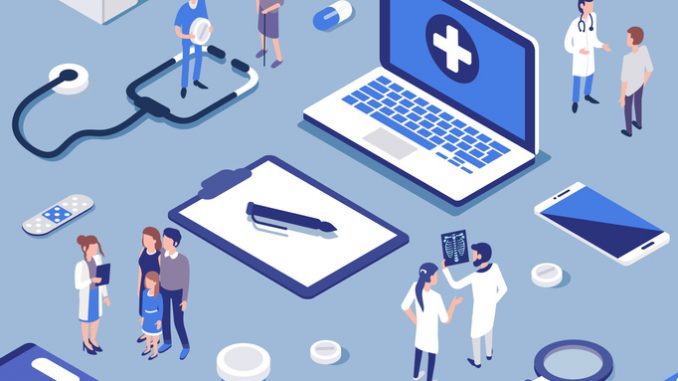
by USF Health
The federal government has invested in a number of initiatives aimed at improving training and development of healthcare employees while increasing the supply of new faces to healthcare over the years. A significant number of those new faces may be expected to come from underrepresented and disadvantaged populations courtesy of programs such as the Scholarships for Disadvantaged Students (SDS) program.
While those government efforts have made strides toward diversifying the healthcare workforce, their impact on diversity in informatics is minimal.
According to an analysis in the journal Evaluation & the Health Professions titled “Diversifying the Healthcare Workforce Begins at the Pipeline: A 5-year Synthesis of Process and Outputs of the Scholarships for Disadvantaged Students Program”, there was a 23.5% increase in SDS scholarships awarded to students in allied health programs between academic years 2008-09 and 2011-12. But the analysis also shows that of those allied health students, none studied informatics as a science specifically. While allied health careers in public health, medical technology and pharmacy may involve elements of informatics, they don’t often provide more than a base level of knowledge that will be necessary in the coming years, as informatics and data analytics play a more prominent role in healthcare.
How Can Diversity in Informatics Be Accomplished?
If programs such as SDS aren’t necessarily steering students toward informatics, the question is: who will?
This is a common topic of conversation among groups such as the Health Information Management Systems Society (HIMSS) and professional development strategists around the world. Organizations such as HIMSS and the American Health Information Management Association (AHIMA) have their own scholarship programs of note, but are they able to reach a broad enough audience to truly help informatics programs recruit the number of students needed and diverse enough students to help health IT organizations achieve the desired level of
cultural competency?
Rachelle Blake, CEO of Omni Micro/Omni Med Solutions, is playing a major role in providing an alternative solution to this problem. Based in Hamburg, Germany, Omni Micro is creating a foundational curriculum for health IT competencies around the world. The curriculum is being developed as part of the EU U.S. eHealth Work Project.
Access to the curriculum will be free and provide base level knowledge for people looking to enter positions in the health IT field. The potential the curriculum has to reach underserved students and professionals is important, not only for diversifying the workforce, but helping with an industry that needs more qualified workers.
“Across the board, informatics programs are not keeping up with the amount of staff we need for ehealth and Health IT careers,” said Blake, who also sits on the education committee of the HIMSS African American Special Interest Group (AASIG).
How Can Informatics Knowledge Become More Widespread?
Another way to make informatics knowledge reach a more diverse population is to integrate it across healthcare professions. Part of Blake’s mission is to create a more technologically savvy workforce across the board. That comes via access to better interdisciplinary training materials for all students entering a healthcare career. Interdisciplinary is the keyword here, as instilling that type of knowledge set in those entering the workforce is something that has to be at the core of an educational experience.
“Too often we’re trained with blinders on, we’re training a nurse to be a nurse,” Blake said. “The nurse will continue down the nurse’s path and too often we’re not looking at how the interdisciplinary component is present within each role in today’s world. We work in teams and collaborate, especially in healthcare. This is a very collaborative time and our electronic tools mandate that we have team-based, collaborative workplaces. Interdisciplinary study is something we need to start teaching from the very beginning, at the competency level.”
How Can Educators Bring Diversity to Informatics?
While the efforts of Blake and others are helping, educators and scholarships can still make a difference. Blake thinks that younger students should be targeted more.
“I recall when I was in high school, colleges and universities would come out and kind of show themselves off,” Blake said of what universities can continue doing to support growing the number of women in the field. “What I believe colleges need to do to get women, young girls and minorities interested in STEM careers is to look more at primary and secondary schools. I remember spending a week working at a hospital when I was young and it changed my life. I was in a real forward-thinking hospital where I spent a week shadowing and it made it really exciting. It started a lifetime of fascinating work. Doing things like that, where they have young kids shadow older students, see what they’re doing, utilize mentorship programs. Showing the kids that this stuff can be fun and lead to a lot of different career opportunities. These days, you’re not stuck in a career for 20 years and once you have this type of STEM training, you have the flexibility to move around if you want.”
For its part, the University of South Florida has announced the appointment of Dr. Haywood L. Brown to the position of Vice President for Diversity, Inclusion & Equal Opportunity. He steps in to also take over as Chief Diversity Officer for USF Health.
“Diversity is also about recognizing the talent each individual brings to an institution and to society in order to contribute to diverse demographics of our communities,” Dr. Brown said. “So much of my work in medicine has been at the community level and to help inspire young learners, especially underrepresented minors to strive for excellence. Getting this opportunity at USF to contribute at the undergraduate level at this time in my career is a dream come true.”
Brown’s hiring is an initiative Blake sees as a step in the right direction, regardless of what school rolls out an initiative like it.
“I think that any and all initiatives to further along the cause of diversification are helpful,” Blake said. “I think just having a name and a face out there dedicated to that cause will energize people. Having the perception of the feeling of inclusion is doing something in and of itself. All these initiatives need drivers. You have to have someone leading the charge and once an organization makes a commitment like that, the organization is moving in the right direction.”
Additionally, USF was recognized last year by Education Dive for its closing of the achievement gap between black, white and Hispanic students.
The Importance of Diversity in Healthcare
As the diversity of aging seniors increases, the healthcare workforce has to reflect the population it cares for. The Evaluation & the Health Professions analysis notes that while “increasing diversity, by itself, cannot guarantee that the healthcare workforce will be equipped to provide culturally appropriate care to America’s diverse populations, continued stagnation in minority representation across the health professions can have unwelcome and costly consequences to the health of the nation.”
It’s not just along race lines either. The gap between females and males persists in STEM careers across the board. While progress is being made by women in health IT, with females occupying high profile roles at agencies such as the Office of the National Coordinator for Health IT, and boardrooms such as Blake’s, women and minorities are not yet adequately represented and do not experience equal pay.
Once women and minorities have made it into healthcare, the industry needs to do a better job of leveling the playing field when it comes to pay, according the 2018 HIMSS Compensation Survey. Minorities are paid, on average, 12% less than their white counterparts while women face even greater pay disparities, especially women of color. Additionally, the higher females climb in the health IT workforce, the wider the pay disparity between them and their male counterparts becomes.
While nonwhites who were surveyed felt least satisfied with their pay, one interesting note to come from it was that women were more satisfied than men.
“We can only speculate at this time as to why this incongruity occurs,” HIMSS wrote in its introduction to the survey results. “For example, it could be that females ‘know’ gender pay disparities exist but do not see it impacting their individual situation, or it could be that females, in particular, need to better understand their worth as digital health workers.”
Article provided by Bisk on behalf of USF Health Morsani College of Medicine at the University of South Florida.
For more information about Online Health Informatics Programs, visit USF Health Online.
